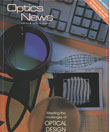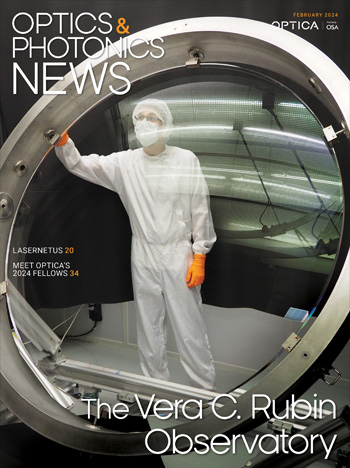
June, 1988 Issue
- Optics in the early forties at the Harvard College Observatory
- Compact zoom lenses
- Diffraction-limited singlet lenses
- Lithographic lenses for microcircuit fabrication
- Gradient-Index optical imaging systems
- Optical design of holographic gratings
- Advances in infrared optical design via diamond turning technology
- Lens design and lens designers
- The gravitational lens effect
- Coatings standards drafted
- Galaxy Wars optics
- Browse all Issues
Feature Articles
Optics in the early forties at the Harvard College Observatory
The author appreciates the opportunity to recall a few of the development efforts having to do with optical instrumentation during World War II at the Harvard College Observatory nearly 47 years ago. Except for the National Defense Research Committee (NDRC) Section 16.1 Summary Technical Volume (Columbia University Press, 1946), nothing has been published formally concerning quite substantial efforts at the Cambridge, Mass., observatory. Presentations, accompanied by slides and minor exhibits, have been made in recent years at local meetings, including the New England Local Section of OSA, the Amateur Telescope Makers of Boston, and the American Astronomical Society, Division on History.
by James G. BakerCompact zoom lenses
Because early photographic zoom lenses replaced either fixed focal length lenses or afocal attachments placed in front of the objective lens, it is not surprising that they contained a fixed rear portion that resembled a conventional photographic objective •and was referred to as a "prime" lens. The front zooming portion was usually afocal and, while normally only two groups are necessary to zoom and maintain focus, the need for a separate focusing group dictated the use of a third front group. Thus, the four-group zoom lens conceived.
by Ellis BetenskDiffraction-limited singlet lenses
With the advent of optical disc systems, the need for compact, low-weight, and inexpensive microscope objectives has led to the development of small, well-corrected singlet lenses. The reduction of aberrations (mainly spherical aberration and coma) is achieved by the combination of mostly old ideas and new technologies like aspherical lens shapes, inhomogeneous lens material, and the application of holographic structures.
by Joseph BraatLithographic lenses for microcircuit fabrication
Reduction lenses used in the hightech cameras known as "steppers" to produce today's complex microchips represent one of the greatest set of challenges to optical engineers in design, as well as manufacturing science and technology. Lens technology has tracked the explosive growth that we have seen in microcircuit complexity in the past decade, but it is difficult to predict just how much further optical technology can be pushed.
by John H. BruningGradient-Index optical imaging systems
Gradient-Index (GRIN) optics is a relatively new technology in optical imaging systems. The idea is to introduce additional degrees of freedom into a lens design by varying the refractive index inside a lens element. If the new degrees of freedom are effective at correcting aberrations, one can generally improve the system performance over the equivalent homogeneous system using the same number of elements. Alternatively, one may reduce the number of elements required to meet fixed performance criteria.
by Susan Houde-WalterOptical design of holographic gratings
Since the invention of the hologram, lens designers have considered this intriguing device for various applications, particularly designs for laser systems. Holographic optical elements (HOEs) may be made directly by computer generation or by optical construction methods. Computer generation is in some senses ideal because the designer has complete control of the hologram grating lines. Computer generation of holograms is of interest primarily for surface holograms rather than volume holograms and is at present restricted to relatively small diameter devices on flat surfaces.
by George LawrenceAdvances in infrared optical design via diamond turning technology
A"diamond turned" mirror or lens surface is generated by conventional lathe and milling operations using a single point diamond tool on numerically controlled machines employing air bearing spindles and slides.1 Components manufactured by this process yield sufficiently accurate surface figure and smoothness for infrared imaging systems in the 3— 5 and 8-12 μm wavebands.
by W.H. TaylorLens design and lens designers
These new developments will allow the lens designer to be less experienced and less knowledgeable, but one is still necessary.
by Warren J. SmithThe gravitational lens effect
Einstein dismissed the possibility that such effects could be seen in part because the angular separations of the images would be so small.
by Marc V. GorensteinCoatings standards drafted
The Coatings Working Group in ISO/TC 172/SC 3, Optics and Optical Instruments, meeting in April at the Center for Research in Electro-Optics and Lasers (CREOL) in Orlando, put the finishing touches on the first two parts of an international coating standard.
by Robert E. ParksGalaxy Wars optics
Difficult as Star Wars optics may be to design, the task is a piece of cake compared to what people in the optical design community may have to cope with some day.
by David Shafer
![A multiplexed image of a human tonsil acquired. [NIAID] using the iterative bleaching extends multiplexity (IBEX) method.](https://opnmedia.blob.core.windows.net/$web/opn/media/images/articles/2024/0424/departments/202404-cover-web.jpg?ext=.jpg)

